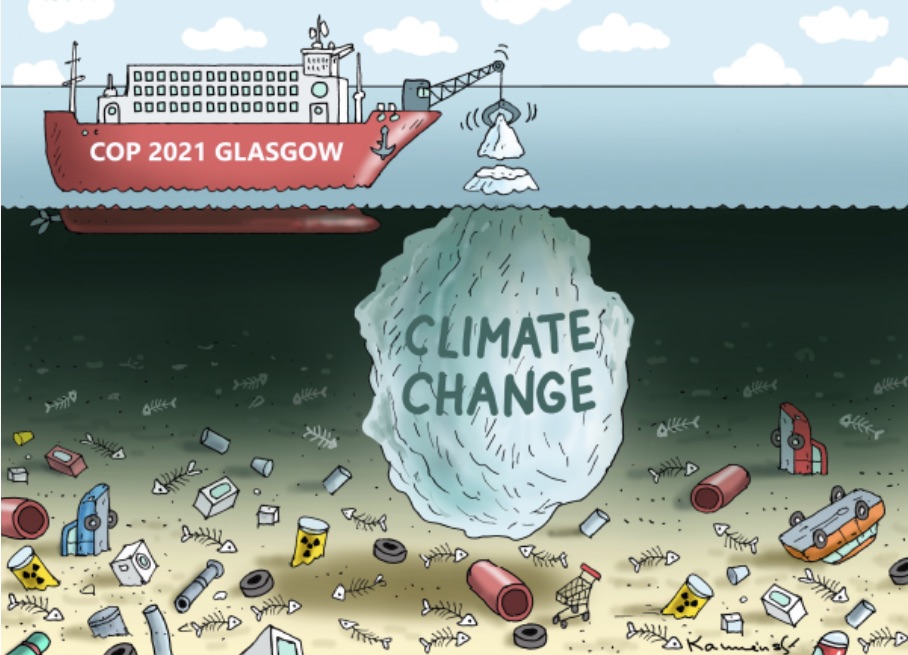The birth of the modern environmental movement occurred in Santa Barbara on January 28, 1969. On that day, a Union Oil drilling rig blew out, spewing 4.2 million gallons of crude oil into the ocean and onto beaches up and down the Central Coast. That spill shocked the nation and spawned an effective national environmental movement. It created a 20th-century model for environmental activism — “Think Globally, Act Locally.” After what seems to be failure at COP26 in Glasgow, Scotland, it’s time to rethink the model turning it into “Think Locally, Act Globally.”
World leaders gathered in Scotland were tasked with ensuring that the world reduce global warming before the planet reaches the 1.5 degrees Celsius (2.7 degrees Fahrenheit) tipping point, after which our world will experience more severe droughts, wildfires, hurricanes, flooding, sea level rise, human displacement, and deaths. Despite more than 100 countries, including the U.S., pledging to cut methane emissions by 30 percent by 2030 and promising to reforest, what is being accomplished will not avoid the coming 1.5C tipping point. This because COP26 is refusing to deal with coal.
Coal is the dirtiest and most destructive emitter of greenhouse gases (GHGs). While more than 40 countries pledged to phase out coal, China and India, which burn roughly two-thirds of the world’s coal, made no coal reduction commitments. China did not attend the summit. India, despite its pledge to cut GHG emission to net zero by 2070 (instead of 2050) plans to expand its coal mining. Australia, the world’s 11th largest burner of coal did not announce plans to transition away from it. And, the United States which generates about one-fifth of our electricity from coal did not sign the coal reduction pledge.
Absent eliminating the burning of coal, promises to reduce methane and replant forests will not reduce global climate emissions below the 1.5°C tipping point by mid-century. Indeed, the latest UN Emissions Gap Report (UNEP) found the climate promises being developed in Glasgow put the world on track for a temperature rise this century of 2.7°C.
There’s no mystery why the U.S. did not sign the coal pledge. President Biden wants the 50-50 Senate to pass his Build Back Better (BBB) agenda through reconciliation. Senator Joe Manchin (D-WVA), who owns coal businesses, has already stripped the most coal-reducing measure — incentives for utilities to move from coal to renewables — from BBB. According to the International Energy Agency, without replacing virtually all coal, oil, and gas power plants by 2035, and the remaining coal-fired plants by 2040, our planet will go over the 1.5°C tipping point by mid-century.
Promises and pledges in the face of climate change are cheap. It is binding, enforceable agreements that are needed. So, it’s time to recognize that actions globally begin by thinking locally. Santa Barbara can once again assume an environmental leadership role, this time for the world, by its environmental groups adopting this approach and forming an Alliance to Stop Global Warming.
Foundation funders and high-end donors like this kind of coalition approach. The media also likes it. Given the advent of social media, such an Alliance would become a model for the rest for the world. While it would be up to the Alliance to create its own agenda, it should, in my view, focus on local governments enacting climate change measures, along with ” educating” leaders in Washington as to how these local measures can nationally address the existential threat which will remain after COP26. They should also focus their advocacy on “educating” for larger Democratic majorities in 2022, capable of passing more climate legislation. I realize that this kind of national/ international approach would take local environmental groups out of their traditional roles. However, these are extraordinary times, which require extraordinary measures.
On November 6, 2021, 100,000 people marched through Glasgow demanding action from world leaders to combat climate change. These kinds of demonstrations are absolutely needed on the local level as well. However, without the kind of follow-through that can move world governments to action, they lose their punch. An Alliance Against Global Warming should also work to galvanize local groups worldwide to follow suit. Social media makes this absolutely doable. Indeed, such postings would not only go viral, they would inspire a worldwide political movement aimed at local governments addressing climate change.
COP26 is making it obviousthat relying on world governments to effectively combat climate change is not going to happen. Therefore, it’s up to us, at the local level, to do it.
The environmental movement started here in Santa Barbara. Why not do it again, this time to confront an existential global threat.

 on Google
on Google 


